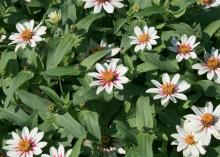Information Possibly Outdated
The information presented on this page was originally released on October 8, 2012. It may not be outdated, but please search our site for more current information. If you plan to quote or reference this information in a publication, please check with the Extension specialist or author before proceeding.
Summer zinnias bring fall color
Even though pansies, viola and dianthus are showing up in garden centers, don’t be too quick to pull up your summer-flowering annuals. The Fall Flower and Garden Fest in Crystal Springs this weekend gave visitors a glimpse of what summer annuals can do for the fall landscape.
Our summers in Mississippi can be brutal, and they even take a toll on flowering summer annuals. But once we turn the corner and start heading towards fall, these plants get a second wind. Like humans, they also appreciate the moderating temperatures.
A group of summer plants that really looked good in the Truck Crops Experiment Station trial gardens were the Zahara zinnia.
Zahara zinnia produce mounds of colorful flowers. The plants are robust and have excellent branching to support the many flowers. These plants also have a natural resistance to powdery mildew.
They come in a wide range of colors, from white to coral rose, and the colors can last until fall. Zahara Double Cherry’s color was pure and a result of cooler temperatures.
My favorite Zahara is the Starlight Rose, a bicolor selection of white petals with a splash of deep rose shining from the center. Our hot summer temperatures cause the deep rose color to vary. I was happy to see the splash of color starting to reappear with the fall weather.
Zahara zinnias are also well suited for container gardening. You can extend the flowering season by bringing the containers inside when colder temperatures arrive. Always plant in peat-based potting media and monitor moisture, as plants grown in a container can dry out much quicker than those grown in landscape beds.
Amending your landscape beds with 3 to 4 inches of good-quality compost at spring planting helps ensure adequate fertility in the fall. During the cool fall season in Mississippi, planting in raised beds results in superior plant growth and flowering because of the increased soil drainage.
Maintain a 2- to 3-inch layer of mulch. Mulch acts as a kind of insulation, keeping soil cooler in summer but warmer in fall. Keeping soil warmer in the fall will encourage the plant to keep producing beautiful flowers longer into the season.
Zahara zinnias are tolerant of drought conditions, but apply supplemental irrigation during periods of extreme drought. Plants do not need as much extra water with the onset of cooler temperatures. If you do irrigate your fall zinnias, use soaker hoses or other drip-type systems, which are excellent, efficient methods of maintaining soil moisture.
Don’t neglect the feeding needs of your zinnias in the fall. You don’t need to use granular slow-release fertilizers, but I recommend using water-soluble fertilizers as an easy way to keep the plants fed.
So go ahead and enjoy the fall resurgence of your summer flowering annuals. There will be plenty of time later this fall to plant cool-season flowering annuals.









